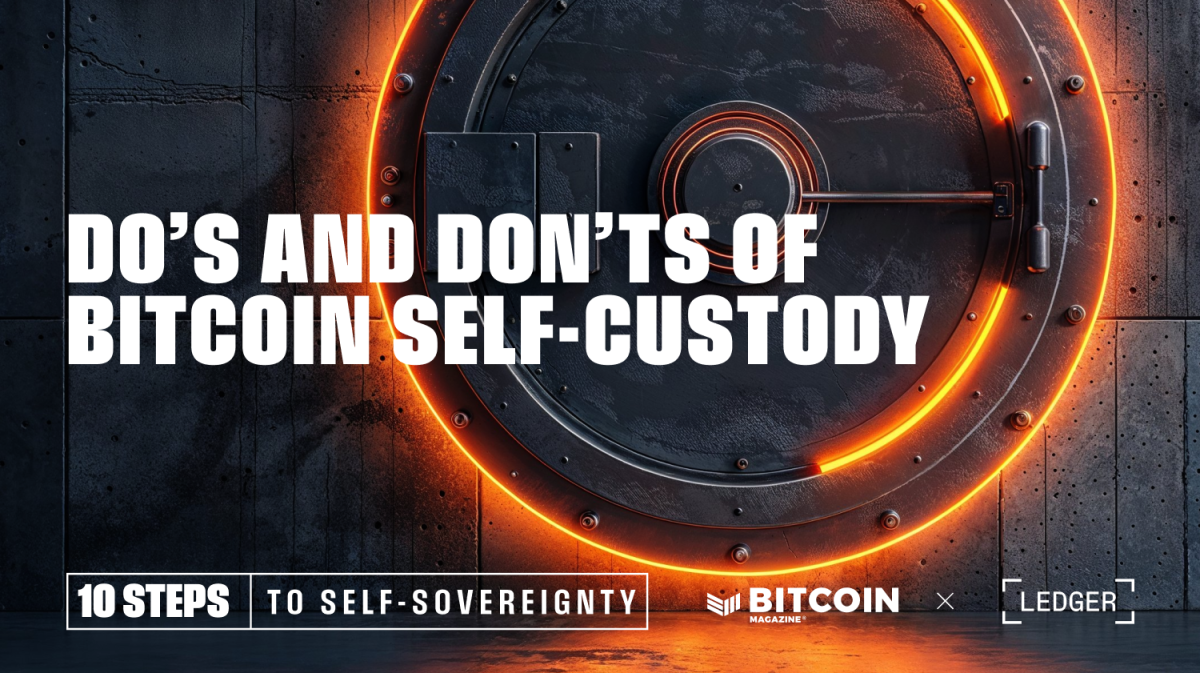The Dos and Don’ts of Bitcoin Self-Management


Bitcoin is a completely decentralized system, meaning there is no ability to cancel a payment or a customer support line to call for help if you run into problems. When you self-manage your Bitcoin, you alone are responsible for the safety of your funds. Self-custody also means that no one can freeze your funds and no one can stop you from making the payments you want. This is a double-edged sword. Self-custody has great benefits, but it also comes with responsibilities.
If you make a mistake and send Bitcoin to the wrong address, it cannot be canceled. Then, if someone gets access to your seed phrase (seed word), there will be no customer support to help you, and that person will now have access to your money. If you lose your keys and seed phrase backup, there is no recovery process to get your wallet back. In that respect, it is very similar to cash. Once it’s gone, it’s gone.
People generally go through life without existential anxiety about having small amounts of cash, but protecting significant amounts of money is a cause for concern, and Bitcoin is no different.
Storage and cryptocurrency wallet
There are many different types of wallets you can use to manage your Bitcoin. However, not all of these provide true ownership of your assets. Here’s a breakdown of the types of wallets you’ll encounter and how to approach self-storage.
storage wallet
Managed wallets are typically offered by centralized exchanges, the same platforms that allow you to purchase Bitcoin with fiat currency. This wallet essentially works like a bank account. You don’t really have control over your money. They may freeze your funds, lock and close your accounts, and refuse to transact or withdraw your money. They offer you the possibility to transact very cheaply with other users using the same wallet, but in return you hand over control of your money to their custodian. It should not be used to store significant amounts of money, and any Bitcoin you purchase should be withdrawn to a non-custodial wallet as quickly as possible.
Non-custodial wallet
Non-custodial wallets all offer true self-custody. Only you have access to your assets. However, wallets that provide self-custody also have various pros and cons. It may also be used for other purposes.
Software wallets, also known as hot wallets, run on your mobile phone or laptop computer. They put control of your funds in your hands, but manage and store your private keys on your device. This exposes you to the risk of compromise by hackers. You should only protect small amounts of money with a software wallet that you reasonably expect to spend over a short period of time.
Hardware wallets are special devices designed to keep your private keys as safe as possible. These devices should be used to store large amounts of Bitcoin. It keeps your private keys offline, inaccessible to threats from hackers, and allows you to sign transactions in a secure environment. One thing to be especially aware of when using a hardware wallet is that most hardware wallets have a screen on the device that is used to display information about where the transaction is being sent before signing. Always double-check the address and amount shown on your device when you sign to make sure your money is going to the right place.
How to Access Self-Custody
Here are some basic steps you can take to interact with Bitcoin in a safe and secure way.
backup test
The first thing you need to do when managing your own money is to create a seed word, also known as a seed phrase. This is like the master key for all accounts you will create with that wallet.
When you first complete your wallet setup, your wallet will generate a random number called a seed, or entropy. From there, the wallet converts these numbers into 12-24 words called seed phrases or seed words.
To promote user safety, a properly designed wallet should verify and prove that it has recorded the seed phrase by asking for some (or all) of the words in the seed phrase. If you’re managing a significant amount of money, it’s always safest to double-check.
To follow this, you will need to create an “Account” which will create the first receiving address for your wallet:
It never hurts to stay safe and double check things. After you finish setting up your wallet, you can reset and reinitialize it before you start trading. Instead of creating a new seed phrase, you can import the one you just backed up. If your first Bitcoin address is the same, you can be sure you have backed up your seed phrase correctly.
Send a test transaction
When you make your first withdrawal from an exchange, you might be a little nervous. Is this address correct? Did I make a mistake? One of the biggest fears many people have about Bitcoin is its digital nature. Everyone has an image in their mind of a movie scene where a teenage hacker compromises government systems to further a conspiracy. Most people don’t understand the first thing about how computers work, but they do know that there are many different ways a computer can be damaged or hacked.
I don’t know about you, but I worry when I know there is a risk that could affect me and I don’t understand how I am exposed to that risk. You can slowly send coins to your wallet as you verify your seed phrase by restoring a backup before using the wallet. If someone compromises how you created your wallet in the first place, they can take any money you send to that wallet as soon as you send it.
So don’t send all your money at once. Send a small test transaction using a very small portion of the Bitcoin you want to keep for yourself. First, make sure the funds actually appear in your wallet. If you really want to check, you can also send those coins back to the following address in your wallet to see if those coins are available.
After making a test transaction and making sure you have the keys needed to spend the money sent to that wallet, you can deposit the rest of your money into that wallet. Once you’ve made a small test deposit without incurring any trades that you didn’t initiate, you can feel much more confident that your wallet is set up securely.
Never create a digital seed phrase backup
Your seed phrase backup is your money. Anyone with access to your seed has full access to your funds. There is no customer support line to call, and there is no chargeback or insurance coverage for stolen funds held in non-custodial Bitcoin wallets. If you mess this up, you’re done.
The hardware wallet you use to actually sign transactions is specifically designed to keep the private keys generated by your seed safe. When backing up seed phrases strictly Immerse yourself in analog things. A piece of paper, a steel plate with letters punched into it, something physical and completely offline.
you should never Take a screenshot or photo of your seed phrase on your phone, keep a backup in a text document, Google Cloud, or iCloud, and more. People’s computers and Internet service accounts are hacked and compromised on a very large and regular basis.
Keeping your keys only on physical media, such as paper, and in secure devices, such as hardware wallets, significantly lowers the risk of your coins being stolen due to your seed phrase being compromised. Your iCloud account can be hacked remotely from anywhere, but someone would have to physically break into the vault to back up the seed phrase to the steel in the vault.
Multisig requires additional backups!
If you are using a multi-signature wallet, Seed phrase backup is not sufficient to recover funds. The point of multi-signature is to increase security by requiring more than one key to sign to spend money. Typically, this requires a minimum threshold of devices to sign each transaction. For example, you may need two signatures out of three. This way you won’t lose your funds if someone compromises or loses a key or two, but there are nuances. You may lose some private keys in multi-signature, but if you don’t keep them every With a public key, your future Bitcoins cannot be found on the blockchain. This is because of the way multisig wallets generate the information needed to process transactions.
When backing up a multisig wallet, you must also back up each individual private key with a backup of the public key (the wallet calls this “xpub”) for every wallet address associated with the multisig. This allows you to find your coins on chain even if you don’t have access to one of your accounts.
Never talk about stacks
Participating in Bitcoin can be a very exciting experience, especially when the price goes up. This could also be a liability depending on who knows your Bitcoin holdings. As mentioned earlier, if someone has access to your seed phrase, they will have access to your money. Bitcoin has the potential to: whopping valuable in the future.
Owning Bitcoin doesn’t mean you have to march it around the world and everyone you know. Obviously, if you are married, it would be very difficult to keep a significant amount of Bitcoin secret from your spouse. If you have a very close friend, it is likely that you will see or observe that friend over time.
But you don’t have to tell everyone you meet that you own Bitcoin. And it shouldn’t be that way. As the value of Bitcoin has increased over the years, physical attacks against Bitcoin users to steal their money have become increasingly common. The more people who know you hold Bitcoin, the more exposed you are to these potential risks.
Don’t go on about your Bitcoin stack to everyone you meet..
finish
Bitcoin can be an intimidating thing to own, even though it shouldn’t be. It’s like cash in a way. If you lose it, no one can do anything about it. But in other ways, it’s not like cash at all.
People worry about holding on to large amounts of cash because if they lose it or someone steals it, it’s gone forever. Bitcoin can back up. If you lose your Bitcoin, you can literally magically get them back if you have a backup. This is because your bitcoins are not in your wallet, but stored on the blockchain. Once you have a copy of your seed phrase, you can regain access to all your BTC, no matter which wallet you use.
You cannot simply “back up” physical cash. Photocopied cash copies are not cash and no one will treat them as cash. However, using the Bitcoin word seed phrase will restore your access to your Bitcoin immediately. that alleviation I feel uneasy when I compare Bitcoin to something like cash.
Multisig wallets offer options to prevent theft. If you have a safe full of cash in your home, someone could break into your home and take everything. With a multi-signature Bitcoin wallet, if you only have one key at home, a thief can’t steal your Bitcoin by breaking into your home and taking your keys. This is cash stuff Can not.
The more cash you have, the greater incentive a thief will have to target you. But if they don’t know you have a lot of cash, they have no reason to target you. Don’t tell them about it. Bitcoin is not a special variable here.
Bitcoin can be a threat to self-storage because of the risks it shares in common with cash, but if you take the time to really learn what tools are available to help you self-storage, it’s not as threatening. In many ways, it can be safer than holding cash.
So don’t worry, just have some patience and take your time to learn the basics that you can do to protect your stack yourself. After a while you won’t even think twice about it.


